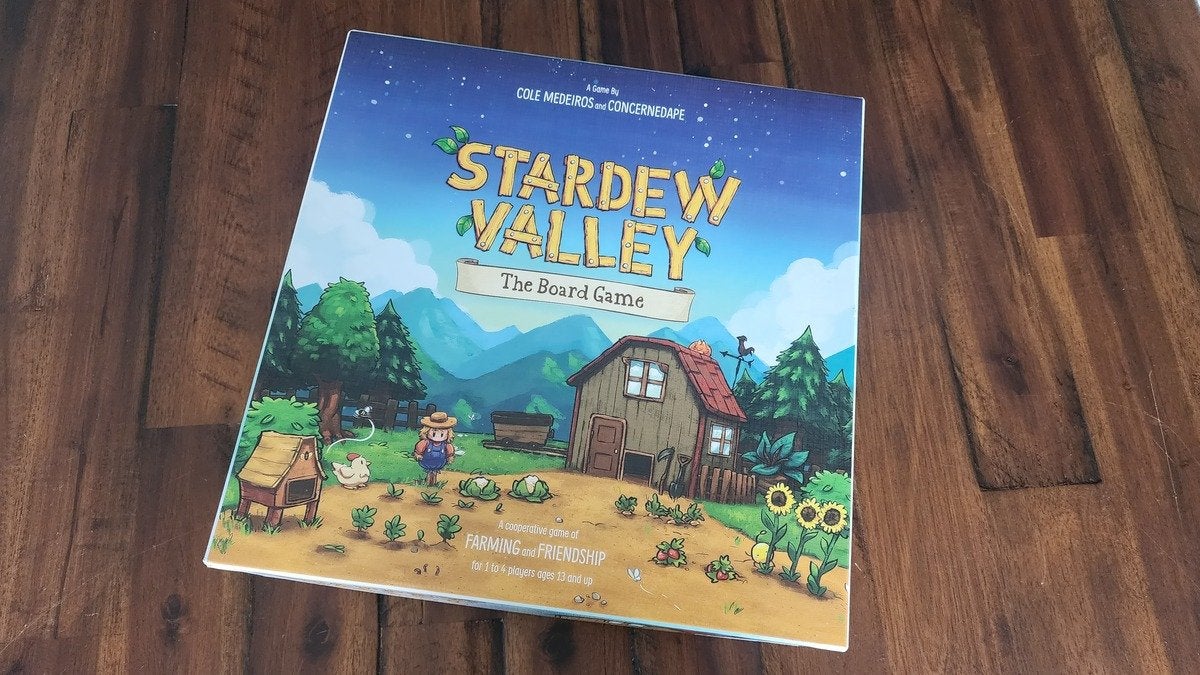![]() Key Takeaway
Key Takeaway
Stardew Valley: The Board Game requires between 1-4 players, and playing on Normal difficulty takes around 45 minutes per player. The goal is to work together to restore the Community Center and complete your Grandpa’s Goals, thereby stopping the Joja Corporation from taking over.
Each round in the game follows the same three steps: the Season Phase, the Planning Phase, and the Action Phase. During the Season Phase, players follow the instructions on the Season Card. During the Planning Phase, players work together to plan their actions for the upcoming Action Phase. All goals must be completed by the end of Winter to successfully win the game.
This paper and plastic adventure translates everyone’s favorite farm life simulator to tabletop format. Initially, Stardew Valley: The Board Game seems overwhelming with a 23-page rulebook teaching you how to play. Included is a huge stock of game pieces, but don’t worry—it’s not as tedious as it appears.
Table Of Contents
Overview of the Stardew Valley Board Game
Stardew Valley: The Board Game requires between 1 and 4 players to work together to restore the Valley by raising animals, growing crops, cultivating relationships with villagers, collecting resources, and growing their farm.
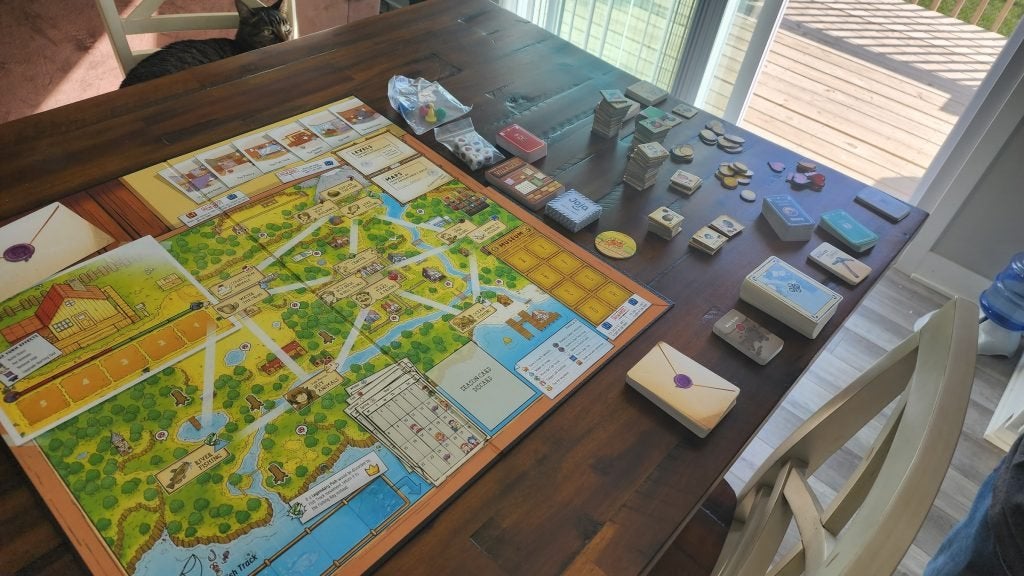
By restoring the Community Center and completing your Grandpa’s Goals, you can stop the nefarious Joja Corporation from moving in and trampling the beauty of the Valley. To play through an entire year takes around 45 minutes per player.
Game Components
When opening the game box for the first time, you might be shocked by the sheer amount of components. Although a few items come packed in their own bags or trays, you’ll want to utilize some rubber bands or bags to make setting up the game less time-consuming during future playthroughs.
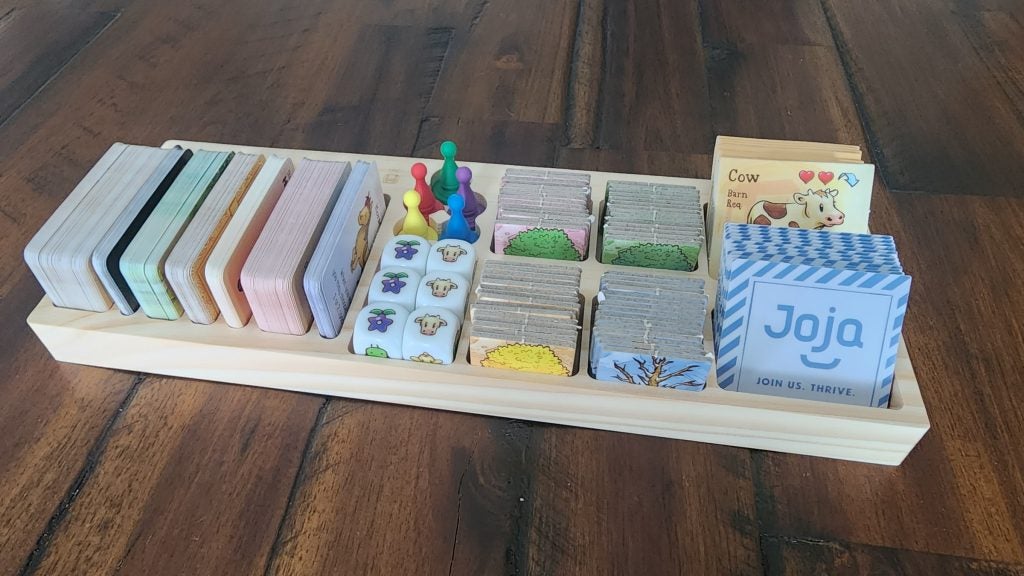
Be sure you have all of the following items before starting your game:
- Game Board
- Player Mats (4)
- Rulebook
- Player Pawns (Green, Yellow, Red, Blue)
- Spouse Pawn (Purple)
- Starting Player Token
- Stardew Dice (3)
- Animal Dice (3)
- Gold Tokens (1g x 10, 5g x 8, 10g x 3)
- Heart Tokens (10)
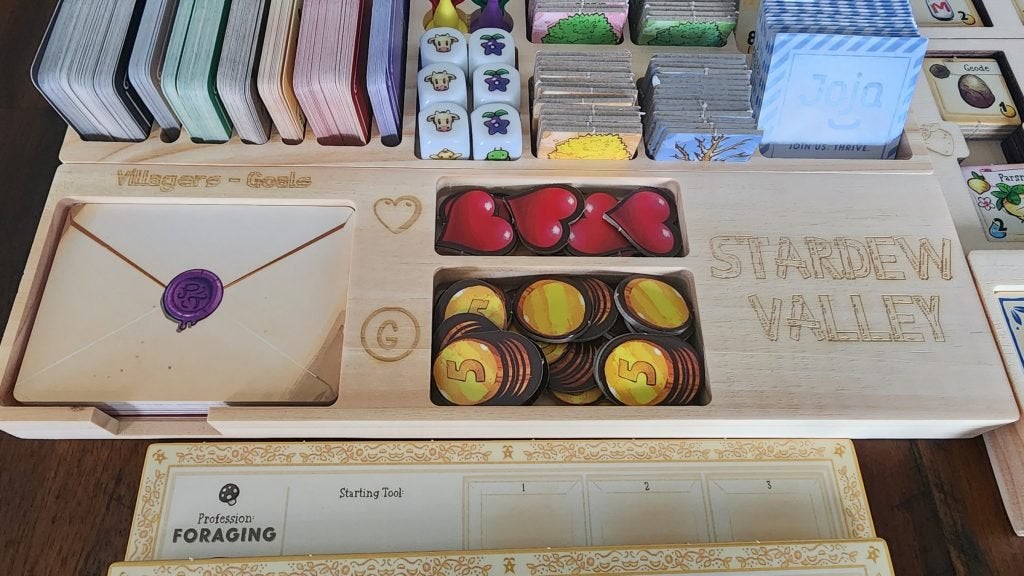
- Starting Tool Decks (19)
- Villager Cards (31)
- Season Cards (84)
- Mine Level Cards (12)
- Map Cards (40)
- Goal Cards (8)
- Bundle Cards (26)
- Profession Upgrade Cards (64)
- Item Cards (50)
- Epic Item Cards (17)
- Event Cards (38)
- Mine Event Cards (16)
- Tile Tray
- Building Tiles (9)
- Animal Tiles (8)
- Joja Tiles (13)
- Crop Tiles (48)
- Ore/Geode Tiles (16)
- Bug Meat Tiles (4)
- Animal Resource Tiles (24)
- Stone Tiles (4)
- Forageable & Tree Tiles (60)
- Artifact & Mineral Tiles (40)
- Fishing Tiles (60)
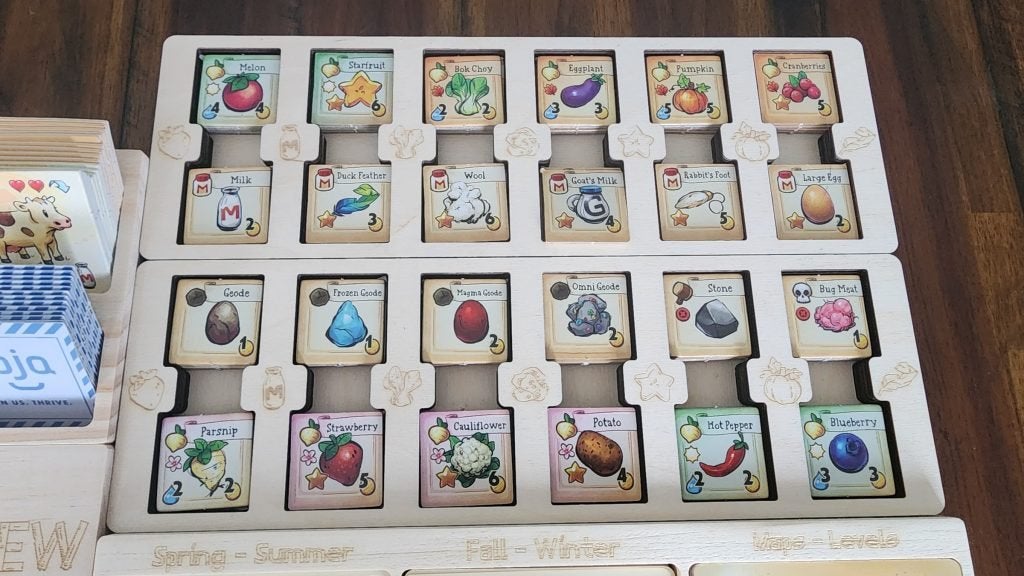
Setting Up the Game
With so many components to juggle, setting up the game can take a bit of time. Follow these instructions and be ready to play in no time!
- Place the game board on the table with the Stardew Dice, Animal Dice, and Spouse Pawn beside it.
- Place the following card decks beside the board after shuffling them: Villagers, Items, Epic Items, Events, Mine Events.
- Place the Tile Tray near the board. It should contain 4x of each Crop, Animal Product, Stone, Bug Meat, and Ore/Geode.
- Place all Artifacts and Minerals into the included gray bag and all Fishing tiles into the included blue bag. Set the bags aside.
- Put one Parsnip in the second field slot, and ensure the tile is placed Normal side up. (The Quality side is marked with a gold star.) Congratulations, you’ve planted your first crop!
- Mix up the 11 pink Spring Forageable tiles and place one facedown on each Foraging spot on the game board. Be sure to place the Tree tiles on the appropriate Tree spots with the leafy side face up.
- Draw 5 random Fishing tiles from the blue bag and place one in each slot on the Fish Track at the bottom left corner of the board.
- Sort the Mine Level Deck by number, ensuring that Level 1 is on top and Level 12 is on the bottom. Place the stack faceup onto its assigned space on the board so that Level 1 is visible.
- Shuffle the Map Cards and draw one. Place this card faceup on the board in its space beside the Mine Levels.
- Build the Season Deck and place it facedown in the Season space on the board. If this is your first game, use the Standard Season cards marked with a Junimo.
- Draw one random Bundle for each Community Center Room and do not look at it. Place each Bundle facedown onto its matching room at the top right of the game board.
- Shuffle the Goals deck and draw four cards. Place these faceup on Grandpa’s Letter at the top of the board.
- Create two stacks of Animal Tiles on the left edge of the board, with Coop Animals in one stack and Barn Animals in the other. Place the Coop Building Tile on top of the Coop Animal stack and the Barn Building Tile on top of the Barn Animal stack. Draw two random Building Tiles and place them beside the Coop and Barn.
- Each player will select a Player Mat to determine their Profession and utilize the matching colored pawn. Players then select their Starting Tool Deck and place it on their Player Mat with Level 0 faceup on top.
- The player that recommended playing the game chooses the Starting Player and gives them the Pet Token. The group can choose whether they’d like a pet cat or dog.
- Start the game with 3 Gold tokens.
Once the above steps are complete, your table should look something like this:
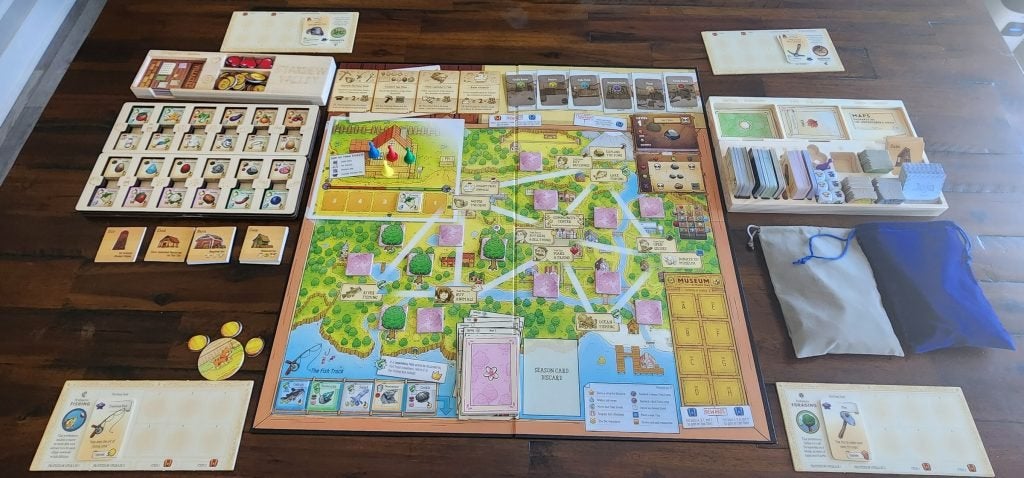
How to Win the Game
The Stardew Valley board game has two main objectives: complete Grandpa’s Goals and restore all six rooms in the Community Center.
At the start of the game, you’ll reveal four of Grandpa’s Goals. All must be completed in order to win.
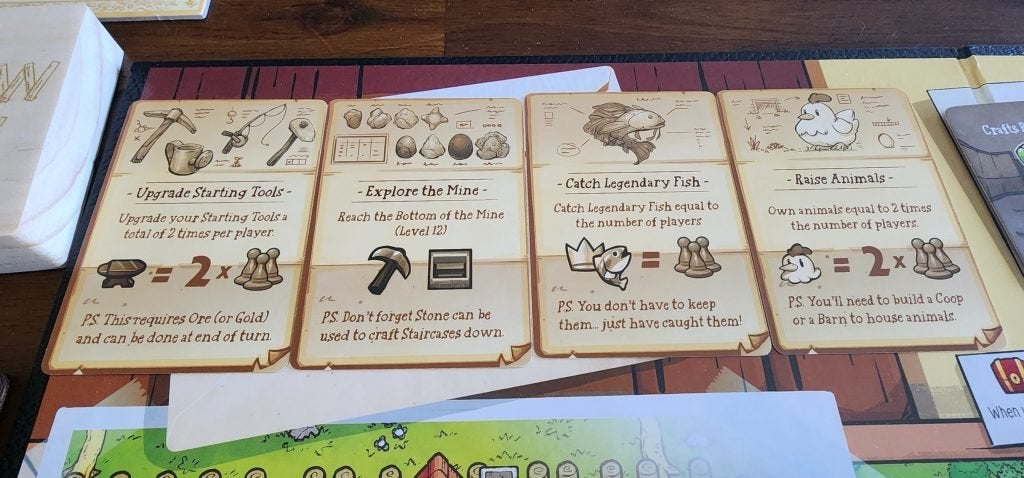
The goals can be any combination of the following:
- Have 10 Gold per player
- Donate 2 items to the Museum per player (Artifacts or Minerals)
- Reach the bottom level of the Mine (Level 12)
- Have 2 animals per player
- Catch 1 Legendary Fish per player
- Have 3 friends per player
- Build 1 Building per player
- Upgrade Starting Tools 2 times per player
At the top right of the game board, you’ll see the six rooms in the Community Center. To restore a room, you must reveal and complete one of several possible Bundles that relate to the room in question. To complete a Bundle, you’ll need to donate the required materials shown on the card equal to the number of players.
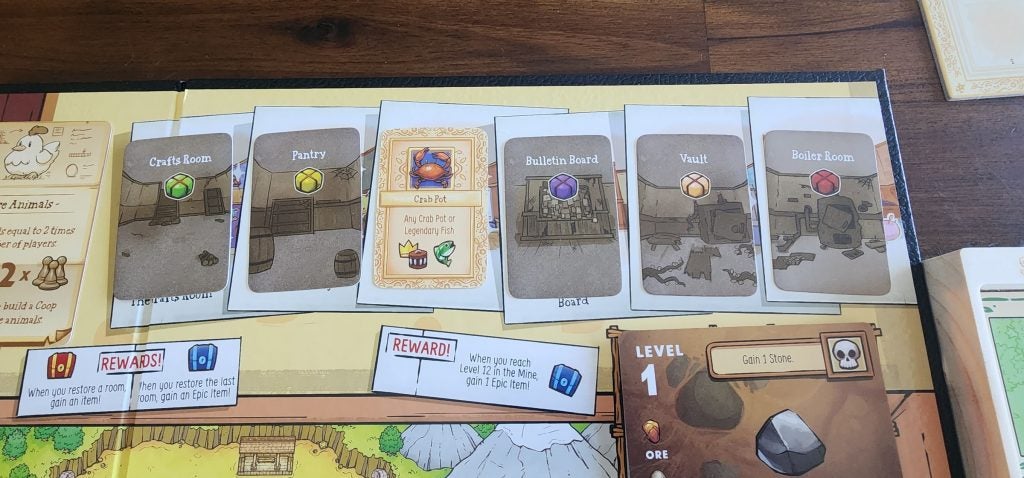
When you start the game, the Community Center Bundles will be face down. To flip them, you’ll need to spend time making friends. Once you pick a Villager Card, you’ll see what kind of items the person enjoys. Gift the listed item to the villager to gain hearts, which can be spent to reveal each room’s Bundle Card.
How to Play
Each round in the game follows the same three steps: the Season Phase, the Planning Phase, and the Action Phase.
The Season Phase
The current season will dictate what the group’s turn will look like. To start, the player with the Pet Token will draw a Season Card and follow the instructions shown from top to bottom. These instructions come in the form of icons.
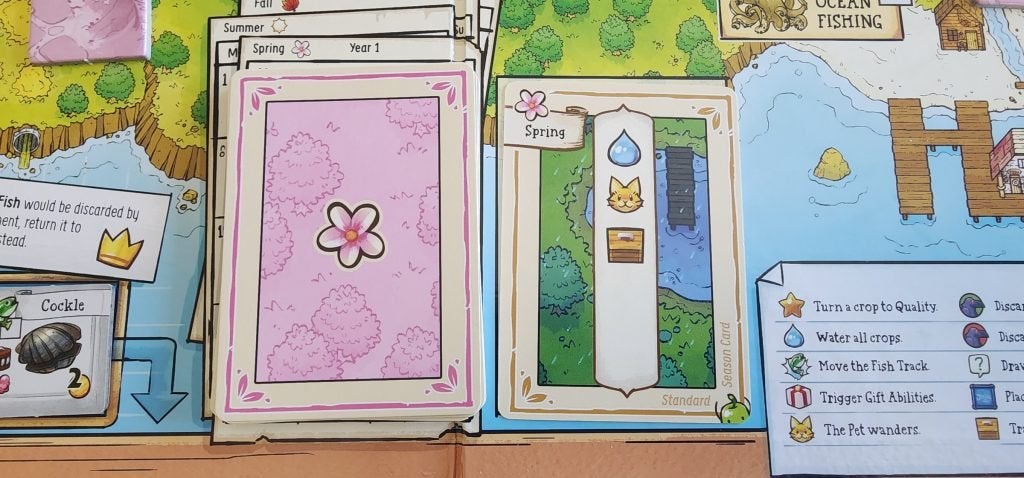
Possible instructions include:
- Quality Crop – Indicated by a Star icon. Flip any planted crop so that its Quality side—the side marked with a Star—is faceup.
- Fish Move – Indicated by a Fish leaping from the water. Discard the two rightmost Fish Tiles from the Fish Track at the bottom left of the board. Slide the remaining tiles to the right to fill the empty slots and draw two new tiles to place on the left. Any Legendary Fish should be returned to the bag.
- Rain – Indicated by a water droplet. Move all planted crops one space to the right. Any crops that are moved off the track are harvested and should be placed in the Starting Player’s inventory.
- Gift – Indicated by a gift box. Each player chooses one of their befriended villagers and activates their Gift Ability. Afterward, trigger the effect of all non-villager cards with Gift Symbols.
- Event – Indicated by a speech bubble with a question mark. Draw an Event Card and follow its instructions.
- The Pet Wanders – Indicated by a cat’s face. The Starting Player passes the Pet Token to the player on their left.
- Green Crow – Indicated by a crow on a green background. Choose one of your crops in a green field to be discarded. Field 3 is both red and green.
- Red Crow – Indicated by a crow on a red background. Choose one of your crops in a red field to be discarded. Field 3 is both red and green.
- Joja – Indicated by a blue Joja logo. Draw a Joja Tile and place it on its corresponding spot on the board. While these tiles have no immediate effect, they will make the impacted location less useful overall.
- Shipping Bin – Indicated by a wooden box. Players can trade and sell resources.
In the Season Deck, you’ll find four Season End Cards, one for each season. When a Season End card is drawn, follow the instructions on the card to prepare for the next season.
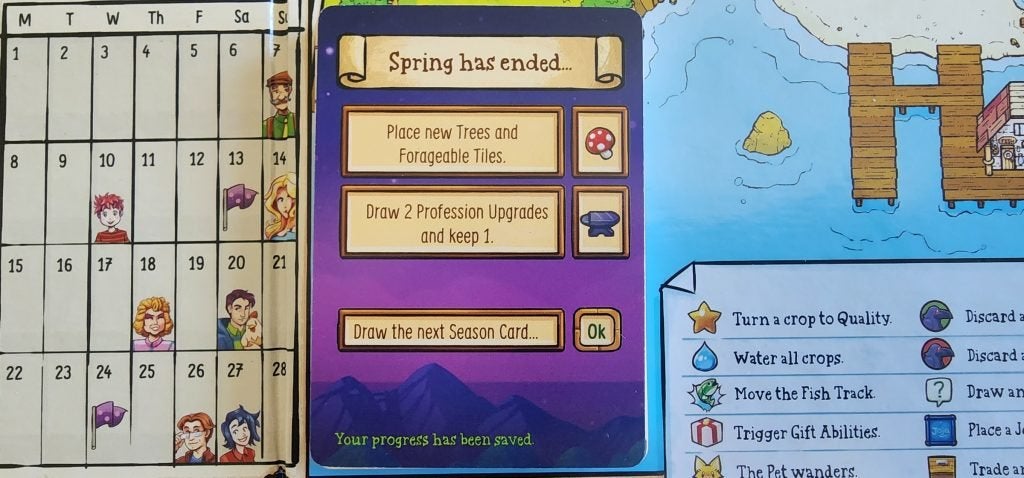
The Planning Phase
During this phase, players can discuss what they intend to do during the turn. They can also trade item cards or resource tiles. It’s important to work together for the good of the farm, so be sure to take your time figuring out the most useful actions.
Once each player has figured out what they would like to do, they can move their pawn onto their preferred location. This does not count as movement.
The Action Phase
After following the instructions on the Season Card during the Season Phase and deciding which actions to take during the Planning Phase, it’s finally time to take action! The Starting Player goes first during this phase, followed by the next player clockwise. Players must complete all of their actions before the next player begins their turn.
Players have two options during their turn. First, they may take two actions at their current location. Second, they may take one action at their current location, move one space along a path on the board, and then take a second location at the new location.
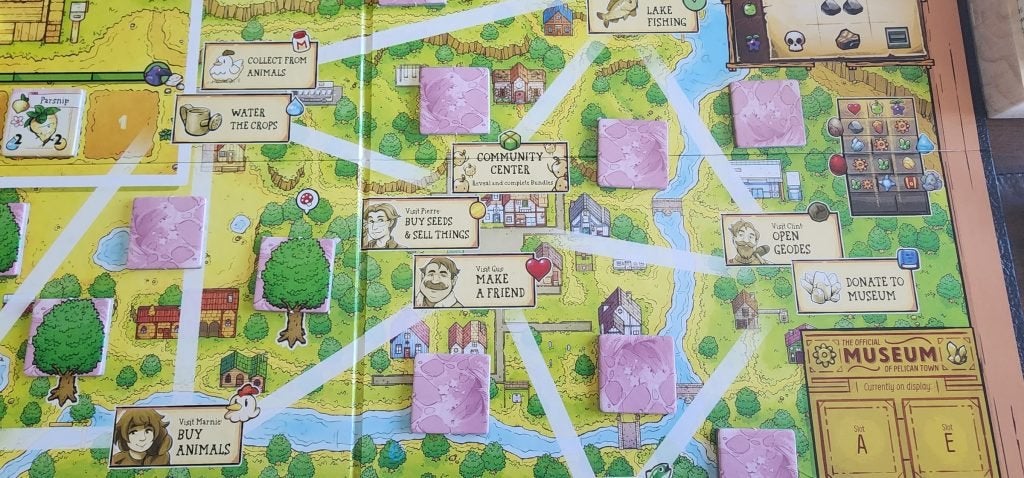
There are many possible actions players can take during their turns:
- Water Crops – Spend one action to move all currently planted crops one space to the right. If a crop moves off the track, it is harvested and placed into your inventory.
- Collect Materials from Animals – Spend one action to roll three animal dice. An Animal Tile can be activated once for each die that matches its icon. For example, if players have two cows, rolling two Cow icons would grant four Milks. Animals flipped to their Happy side generate Quality resources. You can make them happy by petting them at the end of your turn!
- Buy Animals – Spend one action to visit Marnie to buy animals. You must have the appropriate building—either a Coop or Barn—to do so. Multiple animals can be purchased at once as long as you have the gold.
- Reveal and Donate to Bundles – Spend one action to visit the Community Center to reveal and/or donate as much as you can towards one of the possible Bundles. To reveal a Bundle, you’ll need to discard a number of Heart Tokens equal to the number of players.
- Buy and Plant Seeds – Spend one action to visit Pierre’s General Store to buy seeds and/or sell resources. Seeds cost one Gold each and are planted immediately upon purchase into an empty field. The watering cost, seen at the bottom left of the crop’s token, dictates which field it must be placed into.
- Make a Friend – Spend one action in Town to reveal the top card of the Villager Deck. If you’re able to do so, you can give them a gift to make them your friend. Any resource can be gifted as long as it isn’t something the Villager hates, and as long as it does not display the red No Gift icon.
- Open Geodes – If you have any Geodes in your possession, you can visit Clint to open them at the cost of a single action. Roll one Stardew Die per Geode, then consult the chart on the board to see your result.
- Donate to Museum – If you’ve discovered any Minerals or Artifacts, you can donate them to the Museum by visiting Gunther. Spend one action to place the Mineral or Artifact on the corresponding letter at the Official Museum of Pelican Town.
- Explore the Mine – To find Stones, Ore, and Geodes, you’ll need to explore the mine. Spend one action at the Mountain to roll two Stardew Dice to see what you encounter—beware, it could be a monster! The current Map Card will explain the outcome of your roll, indicating an appropriate row and column.
- Buy Buildings – Spend one action and donate any necessary materials and gold to Robin to construct a building.
- Go Fishing – Visit the River, Lake, or Ocean and spend one action to go fishing. Look at the available fish at the lower left-hand side of the board and visit the appropriate location of the fish you’re trying to catch. Roll all three Stardew Dice and try to get the matching symbols at the bottom left of the Fish Tile to successfully catch your fish of choice.
Return your pawn to the Farmhouse after you have completed your last action. Upon doing this, you may trigger any one End of Turn effect as much as you would like as long as you have the necessary materials or gold. (These effects are listed on the board.)
You can discard stones to descend further into the Mine by building a staircase, pet animals to make them happy, upgrade your starting tool to the next level, or remove a Joja tile by discarding a Heart Token or five gold.
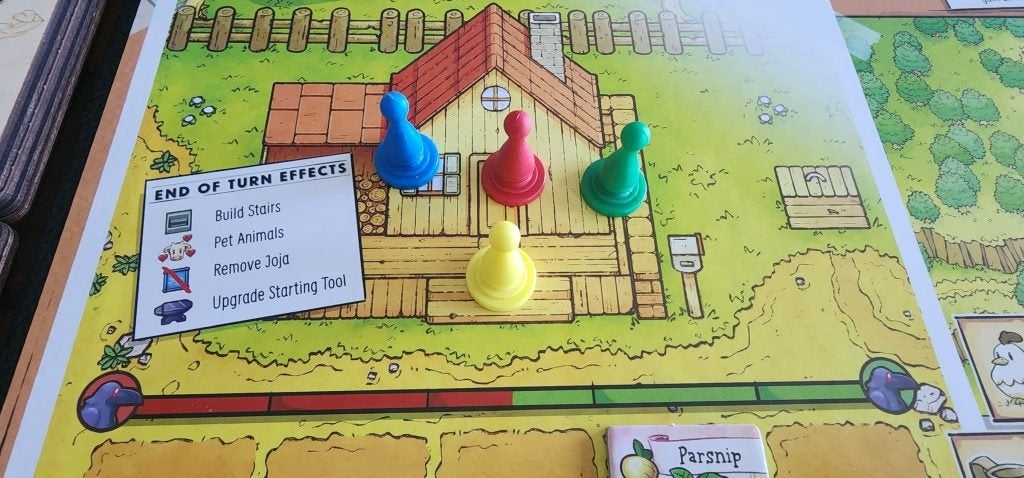
Changing Game Length and Difficulty
A standard game spanning one year will take around 45 minutes per player, but it’s possible to speed this up if needed. To slice the game’s time in half, use only two Season Cards, two of Grandpa’s Goals, and three random Community Center goals.
It’s also simple to make the game easier or more difficult with only a few small tweaks. We’ve included the layout for the ‘Normal’ difficulty above, but altering the difficulty to be easier or harder is a breeze.
If you’d like to take things easy while learning how to play, try to complete four of Grandpa’s Goals only. You can also make the game simpler by starting with one or more Community Center bundles faceup on the board.
If you want more of a challenge, try to complete four of Grandpa’s Goals, six Community Center bundles, and leave no Joja Tiles on the board at the end of the game.
Stardew Valley: The Board Game offers fans an entirely new way to enjoy Eric “ConcernedApe” Barone’s beloved farm-sim. Although we did our best to simplify the game’s instructions, the best way to learn is to play! Sit down with some friends and take your time learning the intricacies of this love letter to one of the coziest video games of all time.


